The latest offering of Visual Studio contains many features. It has come a long way since it was released. Well, let’s just quickly dive in on how a beginner can get started with VS. So, first of all, you will need to decide if you are gonna use an online installer or get it offline first. This is strangely complicated. Due to the presence of third-party components like Android Emulator and iOS SDK, etc. in the package, Microsoft cannot directly host the offline ISO images as it used to until VS 2015. Hence, there are two different ways to download the software depending upon if you want an offline or an online installer. Let us just go through both of them one by one.
How to install Visual Studio
Offline Method
Getting the right edition
First of all, you need to make sure what edition of Microsoft Visual Studio you actually want to download. Then, you will have to need to get the suitable web installer for that particular edition. The following links are for the web installer of your desired edition of VS 2017.
- Get Visual Studio Community 2017 from here.
- Find Visual Studio Professional 2017 from here.
- Download Visual Studio Enterprise 2017 from here.
Getting all the files for an offline cache
This area is slightly tricky. First, you will have to judge what development components you need to download. There is a separate command (yes! command) for .NET web and desktop development packages, a separate one for .NET Office Development, and more.
Let us just get started on each component. You need not get all the components; get just those that matter to you.
First, open Command Prompt with Administrator Rights.
Then, Navigate to the location where the installer that you just downloaded is stored.
Now, start executing the following command line instructions as per your need.
- For .NET web and .NET Desktop development, run this:
vs_community.exe --layout c:\vs2017layout --add Microsoft.VisualStudio.Workload.ManagedDesktop --add Microsoft.VisualStudio.Workload.NetWeb --add Component.GitHub.VisualStudio --includeOptional --lang en-US
- For .NET Desktop and Office Development, run this:
vs_community.exe --layout c:\vs2017layout --add Microsoft.VisualStudio.Workload.ManagedDesktop --add Microsoft.VisualStudio.Workload.Office --includeOptional --lang en-US
- For C++ desktop development, run this:
vs_community.exe --layout c:\vs2017layout --add Microsoft.VisualStudio.Workload.NativeDesktop --includeRecommended --lang en-US
- For the complete feature packed offline collection of components, run this:
vs_community.exe --layout c:\vs2017layout --lang en-US
If you want to not use English as the language for the software, just swap en-US in the commands above with your desired language.
Installing Visual Studio from the downloaded cache
Just in case you wish to ensure that you install only those files that you have downloaded, you can run this command line instruction to verify.
vs_community.exe --layout c:\vs2017layout --add Microsoft.VisualStudio.Workload.ManagedDesktop --add Microsoft.VisualStudio.Workload.NetWeb --add Component.GitHub.VisualStudio --includeOptional --lang en-US
Now, finally to install VS from the downloaded files, run this command line instruction.
c:\vs2017layout\vs_community.exe --add Microsoft.VisualStudio.Workload.ManagedDesktop --add Microsoft.VisualStudio.Workload.NetWeb --add Component.GitHub.VisualStudio --includeOptional
Online installation
To download Visual Studio with an online installer, just download one of the following files according to your desired edition.
- Get Visual Studio Community 2017 from here.
- Find Visual Studio Professional 2017 from here.
- Download Visual Studio Enterprise 2017 from here.
Just run the file that you just downloaded. After that, you will see a screen similar to this.
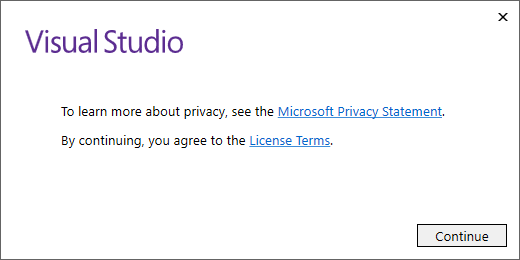
Now, click on continue and now you will see this page.
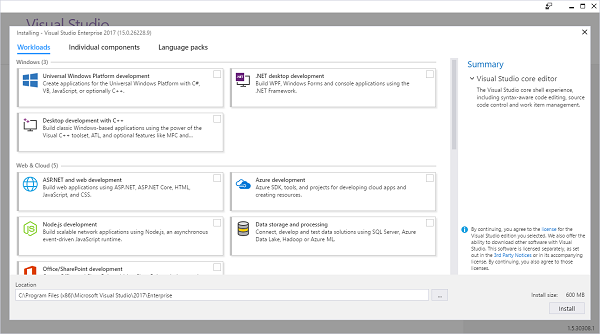
On this page, you will have to select the components that you need to download. Select them and click on Install.
After this, you will see VS downloading and applying components that you selected as shown in the screenshot below.
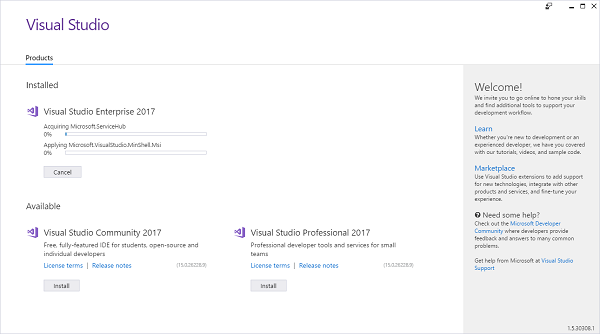
After this, you just have to plug in your device in case you are using a laptop or a Surface device. This is so because you don’t want your computer to go to sleep while this installation is taking place. And when your installer is done with applying all the required components, you will see this screen.
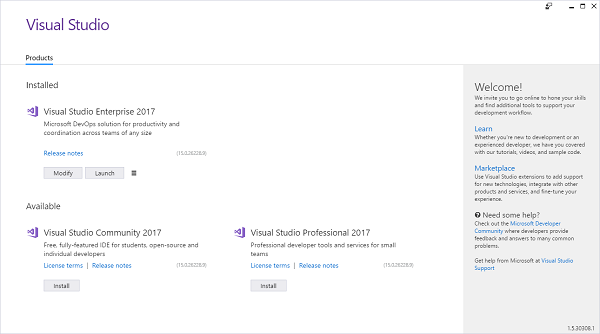
Eureka! You have Visual Studio 2017 installed on your machine. You can find it in the Start Menu as shown in the screen snippet below or else find it as a shortcut on your desktop.
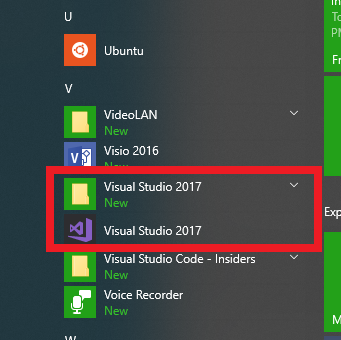
Now, when you run Visual Studio, it will ask you to sign in with your Microsoft Account. If you are using Professional or Enterprise edition, I would recommend you to sign in with the email that you used to buy the subscription. After you are signed in, you will see this Get Started page.
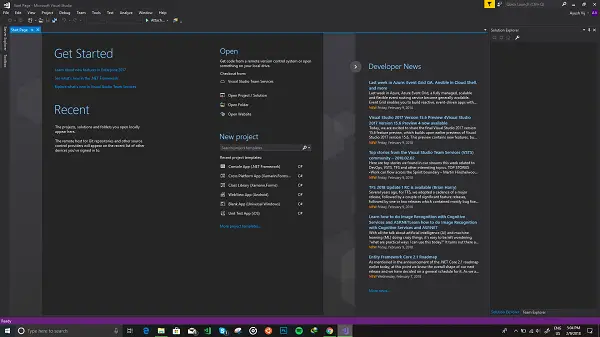
First, we will see how things work inside VS 2017. Navigate to File> New > Project. A small window will pop up now which will resemble this as shown in the screen snippet below.

Just for starters and a simple program example, Choose the Visual C# library in the left panel and Console App in the list of components. And now, hit OK.
This will create a new project based on a C# Console App and open it.
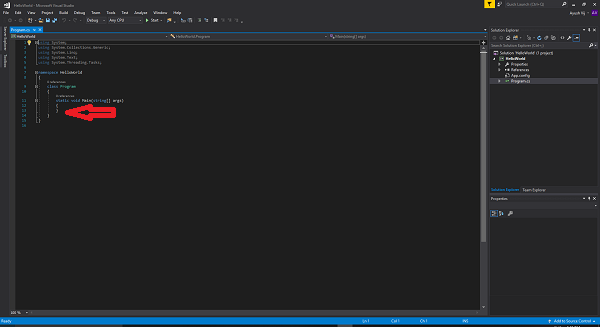
Now, you can start writing your code in between those curly braces as marked in the snippet above.
Write this code in that code block. (A code block is a region between two curly brackets of a particular function. Here, the Main function.)
Console.WriteLine("Welcome to TheWindowsClub.com!");
Console.ReadLine();
Simply now your code should be looking something like this:
using System;
using System.Collections.Generic;
using System.Linq;
using System.Text;
using System.Threading.Tasks;
namespace HelloWorld
{
class Program
{
static void Main(string[] args)
{
Console.WriteLine("Welcome to TheWindowsClub.com!");
Console.ReadLine();
}
}
}
Hit F5 on your keyboard to run the program. Now, a console window will pop up showing you the output as
Welcome to TheWindowsClub.com!
You can see it here.
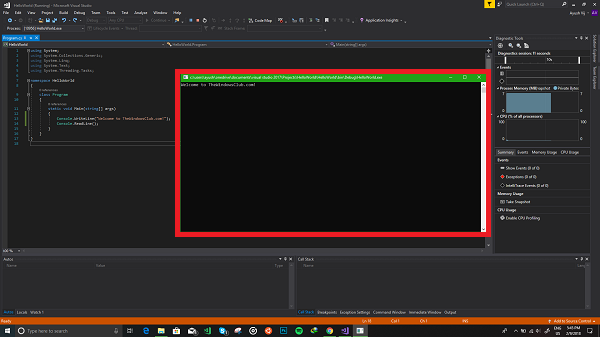
Now due to the code is written as Console.ReadLine(); you will have to press any key on the keyboard to return to your code.
This was a very basic program written in C#. If you would like to discover more, I recommend you check our Tutorials about Languages supported in .NET Framework and .NET Core. If you wish to learn from official videos, Microsoft Virtual Academy (MVA) can help. MVA will even help you get certified by Microsoft directly.
TIP: To learn C# from MVA, I would highly recommend you to refer Bob Tabor’s tutorials which can be found here.
If you have any further queries, feel free to comment them down, and I will try my best to address them as soon as possible.